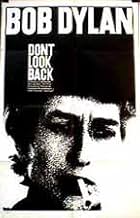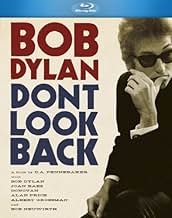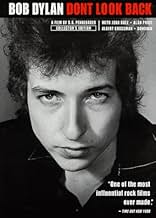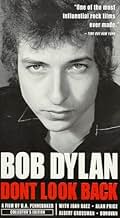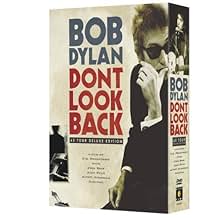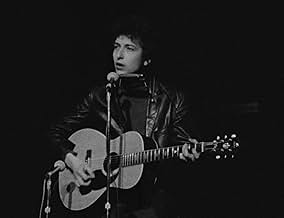अपनी भाषा में प्लॉट जोड़ेंDocumentary covering Bob Dylan's 1965 tour of England, which includes appearances by Joan Baez and Donovan.Documentary covering Bob Dylan's 1965 tour of England, which includes appearances by Joan Baez and Donovan.Documentary covering Bob Dylan's 1965 tour of England, which includes appearances by Joan Baez and Donovan.
- पुरस्कार
- कुल 4 जीत
- Self
- (बिना क्रेडिट के)
- Self - science student
- (बिना क्रेडिट के)
- Self
- (बिना क्रेडिट के)
- Self
- (बिना क्रेडिट के)
- Self
- (बिना क्रेडिट के)
- Self
- (बिना क्रेडिट के)
फ़ीचर्ड समीक्षाएं
It's hard to know how to take Bob Dylan in this documentary. Many of the interviews shown are ones given on the fly just before he goes on stage, and a certain amount of pre-show jitters and nervous reaction is probably to be expected. I would not want to interview a musician just before they are set to perform on strange stages in a foreign country. His interviews come across as a person who has been doing way too much of what we, in fact, see Bob doing all through the film, reading his own press clippings and being very impressed with what he finds. He comes across as a person who thinks he understands all, but is too deep to be understood in turn. So deep, in fact, that mere mortal reporters are not even worth taking the time to explain things to. He wastes the reporter's and the film audience's time playing verbal games, quibbling over choics of words in questions and in general coming across as far more self-important than he really is. This can be seen as anti-establishment, it can also be seen as being a plain old pain in the butt just because you can, to entertain your buddies.
Donovan is there, and is a presence from the start of the film. Bob is very aware of him, has been told that Donovan plays better than he does. Donovan was the British version of Bob and, at times, sold better than Bob did. They finally meet and trade songs, Bob sarcastically choosing to sing "It's All Over Now, Baby Blue" right at Donovan. Joan Baez is there for a portion of the movie, beautiful and ignored by Bob and his entourage. Albert Grossman comes across as a bull in a China shop in England where the genteel older gentlemen who still handled promotion were absolutely no match for Grossman's New York tough guy ways. We see him on the phones, milking every last dollar he can from promoters.
Highly recommended documentary. For what it is worth, besides his music, this is about as close as anyone ever got to Bob Dylan. The film makers were wise in not asking any questions or directing anything, but just in letting Bob talk.
You can feel it. You let your whole being be absorbed by it. You're on a high. Then you catch your breath . . .
Bob Dylan, as depicted in Don't Look Back, is the kind of megastar that can grip you emotionally and intellectually. While their neighbours joined screaming mobs that bayed at the Beatles, Bob Dylan fans listen in rapt silence, taking in every word.
"How many times must the cannon balls fly - Before they're forever banned? The answer, my friend, is blowin' in the wind, The answer is blowin' in the wind."
He inhabits a hallowed quality. Anti-war protesters, educated and disenchanted youth, all see him as their hero. An emblem of hope. Dylan inspired people. Made them feel they could make a difference. Somehow make it a better world.
It was also the Swinging Sixties. Music videos hadn't been invented. In cinema, TV commercials director Richard Lester had kicked off a style of pop musical with the Beatles in A Hard Day's Night (1964). Andy Warhol projected live footage of a band to heighten a live performance (The Velvet Underground and Nico, 1966). Whereas for the opening scene of D.A. Pennebaker's film, Don't Look Back, a deadpan Dylan simply discards one large white card after another. They contain random words from the overlaid soundtrack song, Subterranean Homesick Blues.
That scene has been copied and parodied. Like the kiss-on-the-beach-at-the-edge-of-the-waves in From Here To Eternity, far more people know of and recognise the scene than have ever seen the film. Words are deliberately misspelt. Alan Ginsberg haunts the background as if he's wandered in from another film lot. The scene became one of the first 'music videos'. And the film became one of the early examples of fly-on-the-wall cinema.
Don't Look Back is one of the important movies of the decade for its development of cinema verité, a documentary style with many offshoots but at that point made possible with the new lightweight cameras and sound recorders. These were less intrusive and meant that events could be recorded in a way less staged, the filmmakers having opportunity to follow subjects down corridors or seemingly eavesdrop on conversations.
Don't Look Back follows Bob Dylan through his most iconic phase, dark glasses and leather jacket, on his 1965 UK tour at the height of his fame. (He is about to dispense with a rustic folksy style and upset fans by embracing rock and roll and electric guitars.) It is the Bob Dylan so cryptically emulated by Cate Blanchett in I'm Not There. This is the legend. And the man who became a legend in his own lifetime, constantly reinventing his poetry. He would one day be awarded a special Pulitzer Prize for his "profound impact on popular music and American culture, marked by lyrical compositions of extraordinary poetic power." Not to mention an honorary degree from the prestigious St Andrews University in Scotland.
The follow-the-tour format is a little like In Bed With Madonna. But the immediacy of the film foreshadow movies like Control. Stark black and white photography and a personality that dominates the screen without even trying. Joan Baez (who was near the end of an affair with Dylan) is singing in a hotel room. Dylan looks up with rapt attention (and obvious admiration) for the shy young folk singer Donovan. And clips from his sell-out Albert Hall concert. Throughout and in sharp contrast to almost everyone else captured in all their bygone sixties primness Dylan still looks cool and self-assured in his own skin even by 21st century standards. Somehow his image hasn't aged.
There was something almost mystical about Dylan at the time. Press conferences in the film (that would also be re-staged later in I'm Not There) show journalists nonplussed by the youngsters response. News stories marvel at how thousands of well-behaved youngsters are packing concert halls in essence to listen to several hours of one man's poetry. His lyrics, ranging from poignant stories to stream-of-consciousness collections, were emotionally resonant with metaphors and phrases that could be appropriated to every person's private suffering, every cry of pain behind anti-establishment (and particularly anti-war) sentiments. Dylan never claimed to be any other than a poet and a guitarist. "I got nothing to say about these things I write I just write them . . . I don't write them for any reason. There's no message." His almost angry 1960s disclaimer in the film will still be uttered almost 40 years later at great length in his Chronicles biography. No-one wanted to believe he was only interested in writing poetry. But his openness and honesty in facing down critics is disarming.
For non-music fans and people not specifically interested in the period, the film has slightly less to offer. Poor definition on many hand-held shots gives a lack of visual elegance. The lack of any voice-over means the viewer has to work out many details themselves. And, while it is a remarkable and very vibrant portrait of an esteemed artists at one of the most famous and influential periods of his career, there are maybe too few songs for fans.
Dylan would go on to win Grammy, Golden Globe and Academy Awards and receive several Nobel Prize nominations for literature. The film stops long before he had achieved such mainstream critical acclaim. It never features him singing the credits song, Subterranean Homesick Blues, or the song from which the title is taken. Ironically, it looks back to a period he himself had abandoned by the time the film was released.
a term used to describe films that looked as if they were happening in real time. This is one of those films. It is a gritty black and white documentary that follows the legendary Bob Dylan during a tour in England. This is not a conventional rock documentary where we are shown endless concert footage and interviews with musicians talking about their philosophies and the meanings of their songs. Instead, the camera follows Dylan in a frenzy capturing every detail of social interaction with his fans, entourage, and the press. Dylan appears arrogant but it is no surprise when Pennebaker allows us to see the hypocrisy and greed of the outside world. A memorable moment in the film involves a fan whose invited himself backstage to meet Bob Dylan. He asks him absurd questions such as "what is your attitude on life?" Dylan decides to tease him and the conversation gets pretty ugly. Nevertheless, it is an important scene to the film because it shows us how difficult it is for a superstar such a Dylan to keep a smile and act nice to everyone. Do we gain sympathy for Dylan? We do because we see how alienated he feels among even his closest friends. We also feel a sense of envy for his ability to be so unapologetic and rebellious about his attitude. He is honest but he also has to protect himself from the public. After a Time magazine reporter asks him whether or not he cares what he's saying . Dylan attacks him and then tries to give him a straight answer . "Do you think anyone who comes to these concerts is looking for anything other then entertainment?" The next day, Dylan hears a quote from the papers that describes him as an anarchist. The sequence of these events show clearly how Dylan is at a loss with the public's perception of him. He can't just be himself. He wants to come across as a guy like anyone else but his sarcastic and meaningless interaction with the press only makes things worse. The film also includes appearances with Joan Baez, Donovan, Allen Ginsberg, and Dylan's sleazy manager Albert Grossman. I've seen this film dozens of times and I still see something new with every viewing. It is a true masterpiece.
क्या आपको पता है
- ट्रिवियाThe scene where Donovan visits Dylan in his hotel was generally viewed as Dylan putting the young singer-songwriter in his place when he grabs the guitar and performs "It's All Over Now, Baby Blue." But a 2015 Criterion Collection remaster, with improved sound, revealed that Donovan actually requested Dylan play that song for him. That gave the entire scene a new meaning and revealed Dylan and Donovan as more friends than rivals.
- भाव
Albert Grossman: They've started calling you an anarchist.
Bob Dylan: Who?
Albert Grossman: The papers. That's the word now.
Bob Dylan: Anarchist?
Albert Grossman: Right. Yeah.
Bob Dylan: The newspaper's say I'm an anarchist?
Albert Grossman: Two or three. Just because you don't offer any solutions.
Bob Dylan: You're kidding!
Albert Grossman: Of course.
Bob Dylan: Anarchist? Huh? Give me a cigarette. Give the anarchist a cigarette. Anarchist? A singer such as I.
- कनेक्शनFeatured in Precious Images (1986)
टॉप पसंद
- How long is Bob Dylan: Dont Look Back?Alexa द्वारा संचालित
विवरण
बॉक्स ऑफ़िस
- दुनिया भर में सकल
- $934
- चलने की अवधि
- 1 घं 36 मि(96 min)
- रंग
- ध्वनि मिश्रण
- पक्ष अनुपात
- 1.37 : 1


